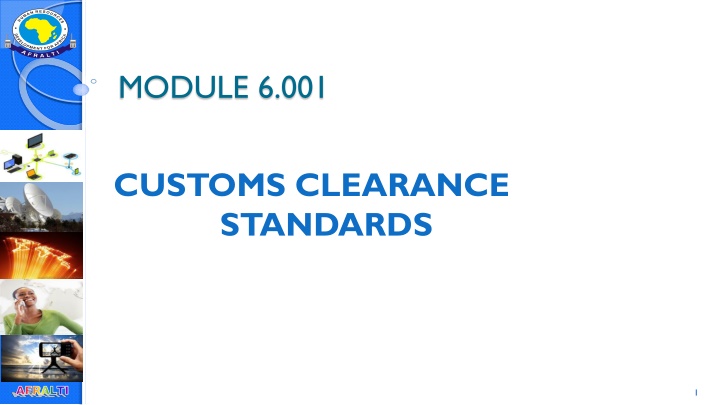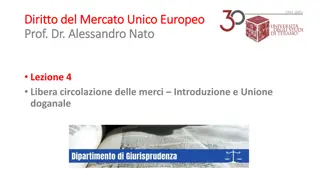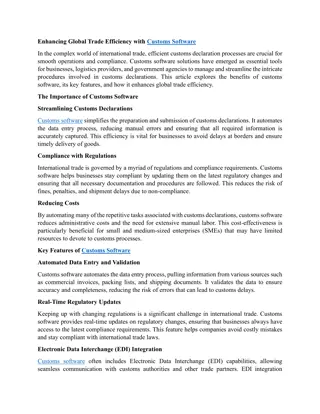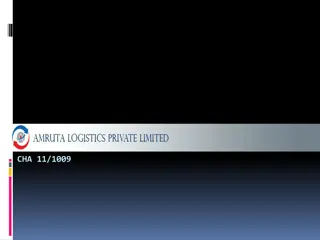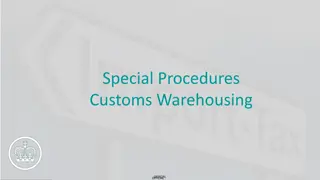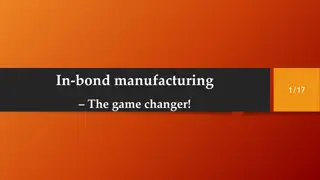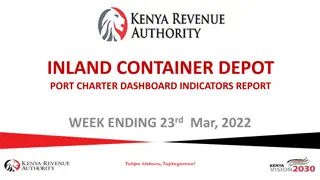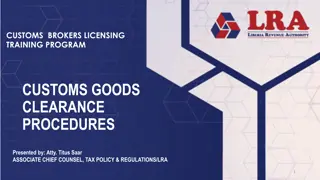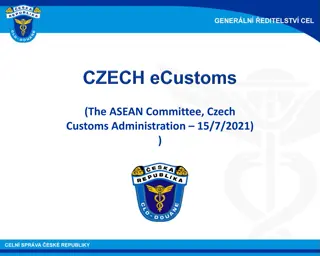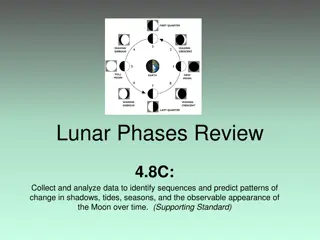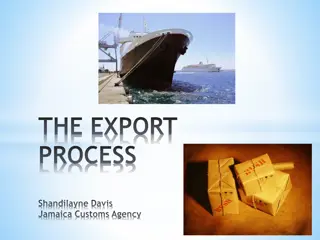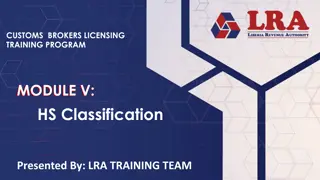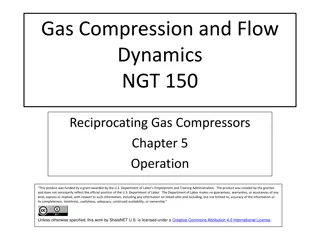Phases of Customs Clearance for Postal Items
The process of customs clearance for postal items involves five main phases: submission of items to customs, culling of mail, customs examination, calculation and payment of duty and taxes. Different countries have varying procedures for handling imported and exported mail, with customs officials making decisions based on risk management and regulatory requirements. The collaboration between postal administrations and customs is crucial to ensure efficient and compliant handling of postal items.
Uploaded on Nov 22, 2024 | 0 Views
Download Presentation

Please find below an Image/Link to download the presentation.
The content on the website is provided AS IS for your information and personal use only. It may not be sold, licensed, or shared on other websites without obtaining consent from the author.If you encounter any issues during the download, it is possible that the publisher has removed the file from their server.
You are allowed to download the files provided on this website for personal or commercial use, subject to the condition that they are used lawfully. All files are the property of their respective owners.
The content on the website is provided AS IS for your information and personal use only. It may not be sold, licensed, or shared on other websites without obtaining consent from the author.
E N D
Presentation Transcript
MODULE 6.001 CUSTOMS CLEARANCE STANDARDS AFRALTI 1
Various steps in Customs clearance of postal items Introduction 1. In summary, there are five phases of customs clearance of postal items, explained below: Submission of postal items to Customs Culling of mail Customs examination Calculation of duty and taxes Payment of duty and taxes I. AFRALTI 2
II. Submission of postal items to Customs 2. In many countries, the Post is required to submit imported and exported mail to Customs. Customs main focus is on parcel mail but letter class mail may also be required to be submitted. Technically, all classes of mail are subject to Customs inspection. 3. Some countries have delegated certain powers to the Post which permits them to screen certain classes of mail on behalf of Customs and not submit those items to the Customs. For example most Customs do not require the submission of letters or cards to them on a regular basis. However in the case of letters Customs usually requests the Post to submit any envelope that obviously contains something other than correspondence (passports, small items like jewellery, money or powders postal officials usually can detect these on basis of feel, appearance or smell). AFRALTI 3
4. In certain countries, the Post is not required to submit all the mail to Customs but rather only those items that Customs request be submitted. Customs will determine, based on review of documents and use of risk management techniques, which items are to be submitted to them 5. The actual submission of items to Customs varies from country to country in some countries, Customs is physically co-located with the Post and in others the Post transports mail to them. 6. Postal officials should refer to Customs any suspicious packages whether or not the class of mail has been routinely exempted from submission. 7. Under chapter 3.1 of the Customer Guide, UPU member countries have provided a brief description of the customs procedures used for postal items. In summary, it explains how a postal administration presents all inbound mail to Customs. AFRALTI 4
III. Culling of mail 8. Customs officials will review the postal items and make a preliminary decision as to which items are potentially dutiable, restricted, prohibited or require examination by another Government Department/Agency (e.g. Agriculture, Health, etc.. Usually these items will be segregated and taken to a separate Customs area. The remaining items or the cages, etc. holding them should be marked as clearedCustoms and be allowed to be delivered. Customs makes the decision on which items require further processing based on the CN22/23 customs declarations documents and based on other factors such as risk management. Processing for packages that have no CN22/23 with the package takes a longer time as these have to be thoroughly examined by Customs to ensure their contents. 9. Some Customs Administrations have empowered the Post office to conduct this step and only potentially dutiable goods or goods subject to control are physically presented to Customs. AFRALTI 5
IV. Customs examination 10. Mail that has been identified as being potentially dutiable or subject to controls at the primary stage is then subjected to a thorough examination by Customs. This may involve accepting at face value the declaration on the CN22/23, X-raying and scanning or opening the package. The purpose of this stage is to confirm if the item is dutiable or subject to controls. Those that are found not to be are returned to the Post office for processing. AFRALTI 6
V 11. In this step of the process, the Customs will determine the duties and taxes to be paid. Customs charge Customs duty and other fees on goods contained in the postal items. The Revised Kyoto Convention defines Custom duties as the duties laid down in the Customs tariff to which goods are liable on entering or leaving the Customs territory .: The expression customsduty is to be interpreted in a wide sense so as to cover all import duties and charges that customs administrations are responsible for collecting in application of the national legislation of each country. 12. Postal administrations shall seek exemption from customs charges in case of items: Returned to sender, destroyed because of total damage to the contents, Redirected to a third country, containing books, catalogues newspapers and periodicals. Calculation of duty and taxes AFRALTI 7
13. The calculation of the amount payable is based on the value of the goods, their origin and the tariff classification. Specific duty may also be payable and this is based quantity. The rate of customs duty is charged on the customs value according to the tariff classification. Rates of duty are set out in official publications usually the Customs Tariff. Rates of duty start at 0%. Rates of duty can be changed by a government by means of a budget. Import Duty is charged as a percentage of the value. The percentage varies depending on the type of goods and their country of origin. 14. Different kinds of duties are explained below. The legal basis for Customs duty is always enshrined in national law. Generally, most goods are subject to ad valorem duty, specific duty, or a combination of both. Specific goods could be subject to anti-dumping duty, countervailing duty, excise tax and/or excise duty. Other duties and taxes are sometimes also applicable VAT/GST or sales tax at import. AFRALTI 8
duty is calculated on a per piece basis or on volume/weight/size (i.e. 10 cents per square foot, 15 cents per device. Anti-dumping duties are imposed when injury to the domestic market or potential injury is established. The duty is calculated taking into consideration the normal value and the export price. Countervailing duties seek to offset injurious subsidization while antidumping duties offset injurious dumping. Excise tax is applicable to a limited range of goods produced within the country. Many countries charge an Excise Duty on imported goods that is equivalent to the excise tax chargeable on domestically manufactured goods (for example: alcohol and tobacco). Excise taxes can be either ad valorem or specific. VAT (or Goods and Services Tax - GST) is a tax on exchanges levied on the value added that results from each exchange. VAT is an indirect tax, in that the tax is collected from someone other than the person who actually bears the cost of the tax (namely the seller rather than the consumer). To avoid double taxation, VAT charged on exports is usually refundable. Many Customs collect VAT or GST on imported goods at the time of their importation Ad valorem duty is calculated as a percentage of the Customs value for duty; Specific AFRALTI 9
Some countries have export duties applicable to specified goods. Export duties are calculated in the same manner as import duties 15. The origin of the goods is a key factor in determining the Customs duty. Different rates of duty apply depending on the goods origin. Origin may be different from where the goods are shipped from. Different goods have different qualifying origin criteria. Essentially if goods are grown, reared or dug up in a particular country they usually qualify as originating there. Otherwise the nature and degree of processing or manufacture is the key factor. Preferential origin rules can confer lower rates of duty. AFRALTI 10
VI Payment of duty and taxes 16. There are different methods for the collection of duty and taxes due. In some countries, the Customs prepares a form indicating the amount due and returns it for collection from the importer. The Post then transfers the appropriate funds to the Customs. In other countries, the Customs retain the package in their premises, informs the importer that there is a package for him and the importer must either come into Customs, pay the duty and taxes due and retrieve the package, or send the moneys due and the package is released for delivery. In some instances, the Post deposits with Customs in advance a sum projected to cover the likely duty and taxes owing over a specific period of time and adjusts the amount periodically when the actual amounts are known. Agreements are in place with the Customs and the Post to cover these situations and to stipulate the cost sharing arrangements. AFRALTI 11
VII 17 Congress resolution C 4/1957 asked postal administrations to use their good offices with the appropriate national authorities to ensure that books, catalogues, newspapers and periodicals are not subject to customs duty. 18 Under UPU rules, items submitted to customs control may be subjected to a presentation-to-Customs charge, the guideline amount of which is set in the Letter Post and Parcel Post Regulations. This charge shall only be collected for the submission to Customs and customs clearance of items which have attracted customs charges or any other similar charge. Postal administrations which are authorized to clear items through the Customs on behalf of customers may charge customers a customs clearance fee based on the actual costs. Postal administrations shall be authorized to collect from the senders or addressees of items, as the case may be, the customs duty and all other fees which may be due. UPU rules and the customs clearance AFRALTI 12
VII Various Standards and Recommended Practices mentioned in the Specific Annex J, Chapter 2 on Postal Traffic regarding clearance of postal items? 19. The clearance of postal items shall be carried out as rapidly as possible. The exportation of goods in postal items shall be allowed regardless of whether they are in free circulation or are under a Customs procedure. The importation of goods in postal items shall be allowed irrespective of whether they are intended to be cleared for home use or for another Customs procedure. The Customs shall designate to the postal service the postal items which shall be produced to them for the purposes of Customs control and the methods of production of these items. The Customs shall not require postal items to be produced to them at exportation for the purposes of Customs control, unless they contain: AFRALTI 13
goods the exportation of which must be certified; goods which are subject to export prohibitions or restrictions or to export duties and taxes; goods having a value exceeding an amount specified in national legislation; or goods which are selected for Customs control on a selective or random basis. The Customs should not, as a general rule, require the following categories of imported postal items to be produced to them : (a) cards and letters containing personal messages only; (b)literature for the blind; (c) printed papers not subject to import duties and taxes AFRALTI 14
When all the information required by the Customs is available from the CN22 or CN23 and supporting documents, the form CN22 or CN23 shall be the Goods declaration, except in the case of : goods having a value exceeding an amount specified in national legislation; goods which are subject to prohibitions or restrictions or to export duties and taxes; goods the exportation of which must be certified; imported goods intended to be placed under a Customs procedure other than clearance for home use. In these cases, a separate Goods declaration shall be required. postal items shall not be subject to Customs formalities whilst they are being conveyed in transit. The Customs shall make the simplest possible arrangements for the collection of duties and taxes on the goods contained in postal items. AFRALTI 15
Thank You Questions AFRALTI 16
